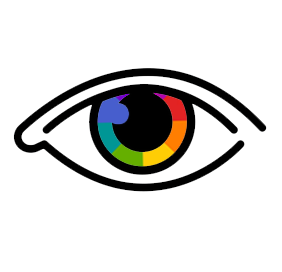Eye color of a child
Eye Color Genetics
Baby’s Eye Color
Future parents are usually wonder what color their children's eyes will be. Knowledge of genetics can help to understand this issue. Though it is impossible to accurately determine the color of a child's eyes, you can roughly calculate the likelihood of a particular color based on the color of the eyes of parents and grandparents.

A baby's eye color changes during the first year of life since not all the pigment that affects the eye color appears at once. Usually is takes a year for eye color to become permanent, but in some children, the color can change until the age of three. Sometimes, eye color can continue to change even through adulthood.
In most cases, eye color can be categorized as blue, green/hazel, and brown. However, different languages and cultures have different names for eye colors. This is due to the fact that many words for color were taken from the everyday life of people. And since the environment in which people lived could be very different from people to people, the description of colors was also different.
The most common eye color in the world is brown. The population of Africa and Asia usually has brown eyes. Light eye color is found mainly in people of European descent.
Melanin
Eye color depends on the combination of pigments that are located in the upper layer of the iris of the eye known as the stroma. In our body there are special cells called melanocytes, which produce melanin. Our color of skin, hair and eyes depends on melanin.
The lower the amount of melanin, the lighter the eye color will be. For example, brown eyes contain more melanin than green or gray eyes. And the blue eye color is caused by very little or no pigment.
Due to the high concentration of melanin in the iris, more light is absorbed and less reflected. Therefore, brown eyes are more protected from sunlight than light eyes.
Blue Eyes Aren't Really Blue
Why are the eyes blue if there is no blue pigment in it? Blue eye color can be explained in the same way as sky blue color. Light is scattered in the atmosphere, and if we are talking about eyes, then in the iris. Light scattering depends on wavelength. Light with short wavelength diffuses better than light with long wavelength. Because blue has a shorter wavelength, it scatters more strongly than other colors. Therefore, the blue color scatters and fills the entire iris of the eye, and we see a blue eye.
Globally, about 8-10% of people have blue eyes.
Green Eyes
Only about 2% of the world's population have of green eyes. As with blue eyes, there is no green pigment in the eye. We see green color because of light scattering. But since in this case there is a small amount of melanin in the iris, the color of the eyes appears green. Eyes may appear slightly darker or lighter depending on different light conditions.
Heterochromia
Heterochromia is a rare condition where the color of one eye is different from that of the other, or the iris of one eye is consists of different colors.
In most cases, heterochromia is limited to different eye colors, but sometimes it can be a sign of a medical condition.
Heterochromia is genetic (congenital), when the eyes are of different colors at birth, as well as acquired. Acquired heterochromia develops as a result of injury, illness, medication. Acquired heterochromia is less common than the genetic form.
Genetics
Previously it was thought that eye color is inherited according to a simple Mendel's law, that is, eye color is determined by just one gene.
Up to 16 genes are now known to affect eye color. The most important of these are called OCA2 and HERC2.
A child's eye color depends on a combination of genes passed on to him by his parents. Different versions of the same gene are called alleles. One allele is inherited from the father and the other from the mother. For example, the OCA2 gene can have 2 versions: brown or blue, and the HERC2 gene has green or blue. The allele responsible for brown eye color is dominant. This means that if one of the two versions of the gene is brown, then the eyes will be brown. Green is dominant over blue, but recessive to brown.
But it's not that simple since many genes inherited from both parents affect eye color. Therefore, it does happen when two blue-eyed parents have a child with brown eyes, although it does not happen often.
Baby Eye Color Calculator
The genetic baby eye color calculator is based on a simple 2 genes model. Using this calculator, you can calculate the likelihood of a child’s eye color. For more accurate results, it is advisable to indicate the eye color of the grandparents.